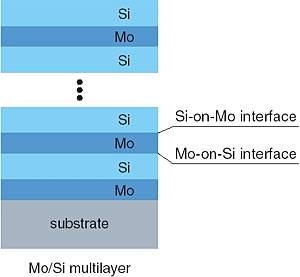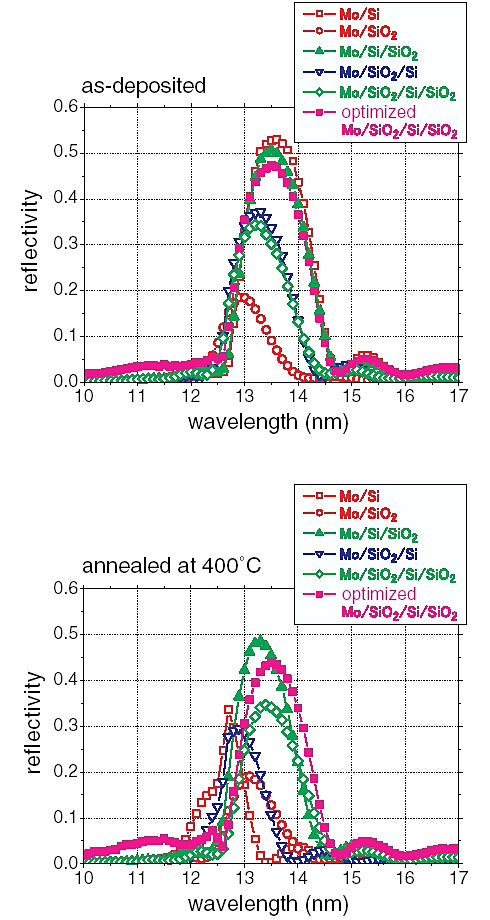The reflectivity of these materials is quite small in the soft X-ray region of the wavelengths below 30 nm due to the X-ray absorption by these materials. Multilayer materials consisting of alternating layered structures of two or more materials have been used for mirrors. Among many types of multilayer mirrors, the Mo/Si multilayer mirror has achieved a high reflectivity at the wavelengths around 13 nm (1 nm = 10-9 m), and has been applied to optical devices for soft X-ray lasers, an extreme ultraviolet lithography (EUVL) process, and so on. When multilayer mirrors are used in a high-power, beam, such as in an X-ray laser and a synchrotron radiation (SR) sources, both high reflectivity and high heat stability are required. It is known that the soft X-ray reflectivity of a Mo/Si multilayer decreases over 300 degree Celsius because the Mo and Si atoms at multilayer interfaces mix with each other, and the multilayer structure is degraded and becomes unstable.
Silicon oxide (SiO2) is a material known to be chemically and thermally quite stable. To improve the heat stability of the multilayer structure, therefore, we applied a SiO2 layer to the Mo/Si multilayer as a barrier layer. We fabricated the various types of Mo/Si multilayers having SiO2 barrier layers at multilayer interfaces (Fig. 5-5). The fabricated multilayers were then annealed and evaluated for structural heat stability.
The structure of a conventional Mo/Si multilayer degrades remarkably at an annealing temperature over 300 degree Celsius. In contrast, all the Mo/Si multilayers with inserted SiO2 layers are thermally more stable than the conventional Mo/Si multilayer. The heat stability of the Mo/Si multilayer increases with the thicknesses of the SiO2 layers at the interfaces, but the thick SiO2 layers decrease the soft X-ray reflectivity. However, the Mo/Si/SiO2 multilayer with inserted SiO2 layers at the Mo-on-Si interfaces and the Mo/SiO2/Si/SiO2 multilayer with an optimized SiO2 layer thickness at each interface achieve high heat stability and retain high soft X-ray reflectivity even after annealing (Fig. 5-6).
The heat stability of the Mo/Si multilayer can be improved by inserting SiO2 barrier layers into the interfaces while retaining high soft X-ray reflectivity. The improved heat stability of the multilayer mirror can simplify the cooling system for the optical elements used with a high-power, beam, such as an X-ray laser and a SR source. In addition, it is expected that experiments in harsh conditions, for example in high temperatures, will be advanced by using these multilayer mirrors having high heat stability and high soft X-ray reflectivity.
|

